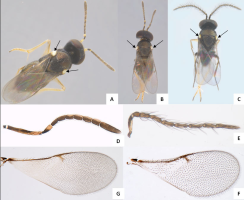Scientific name
Pseudleptomastix mexicana Noyes & Schauff
Taxonomic position
Hymenoptera: Chalcidoidea: Encyrtidae: Tetracneminae
Diagnosis
- Body length: 1 mm (female); 0.6-0.85 mm (male)
- Both sexes (Fig. 6) more or less similar in coloration, dark brown to black with a slight to conspicuous metallic sheen, tegula creamy white to yellowish, abdomen / gaster dark brown with a coppery sheen
- Thorax with silvery white setae
- Forewings hyaline, longer in female with longer postmarginal vein
- Head, thorax and scutellum with reticulate sculpture
Sexual dimorphism
Antenna and forewing show sexual dimorphism. In females, antennal scape is dark brown to about three-fourths of its length, pedicel dark brown in basal half, apically pale orange; flagellum more or less uniform brown, apical segments little darker. In males, scape is basally yellow and apically dark brown, pedicel is dark brown and flagellum dark brown to reddish brown. Besides, in male antenna, all funicular segments are longer than broad and clothed in whorls of long setae, each much longer than diameter of segment and the club is unsegmented. The forewing is longer and narrower with a longer
postmarginal vein in females compared to males (Noyes and Schauff, 2003).
 A, B. Female in dorsal view; C. Male in dorsal view; D. Antenna in female; E. Antenna in male; F. forewing in male; G. Forewing
in female (arrow marks indicate tegulae). A, B. Female in dorsal view; C. Male in dorsal view; D. Antenna in female; E. Antenna in male; F. forewing in male; G. Forewing
in female (arrow marks indicate tegulae). Distribution
Costa Rica; Mexico; Introduced in US (Florida), Republic of Palau, Hawaii, Sri Lanka, India, etc.
Hosts / Biology
A parasitoid of papaya mealybug, Paracoccus marginatus Williams & Granara de Willink in its native range. It prefers second-instar nymphs of P. marginatus (Amarasekere,
2007). Introduced in other parts of the world where the papaya mealybug is an invasive pest and appears to be the least effective of the three parasitoids (the others being Acerophagus papayae Noyes & Schauff and Anagyrus loecki Noyes & Menezes) used at present in classical biological control programmes.
References
- Amarasekere, K.G. 2007. Life history of papaya mealybug (Paracoccus marginatus), and the effectiveness of three introduced parasitoids (Acerophagus papayae, Anagyrus loecki, and Pseudleptomastix mexicana). Ph.D. dissertation, University of Florida, 2007, 114 p.
- Noyes, J.S. & Schauff, M.E. 2003. New Encyrtidae (Hymenoptera) from papaya mealybug (Paracoccus marginatus Williams and Granara de Willink) (Hemiptera: Sternorrhyncha: Pseudococcidae).
Proceedings of the Entomological Society of Washington, 105: 180-185.
|